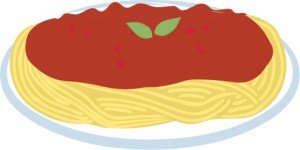Better Pasta Sauce
 Pasta sauce is one ingredient that can add a lot of sodium to your diet. It really pays to compare labels in the food store. Consider that a half cup serving can have more than 600 mg of sodium and that most people use a cup or more on their pasta. This can easily use up almost a day’s supply of sodium for most people. Check out the Nutrition Facts Label for Enrico’s No Added Salt Pasta Sauce - it only has 25 mg of sodium per serving. Here are ways to lower the sodium in your pasta:• Buy pasta sauce that claims low-sodium or no added salt.• Mix prepared pasta sauce in equal parts with no-salt-added canned tomato sauce. This makes the cost per serving less, too.• Use fresh diced tomatoes or no-salt-added diced canned tomatoes instead of pasta sauce.• Low-sodium broth and fresh veggies are a great alternative, too.Penne Pasta Bolognese1 onion, chopped2 teaspoons olive oil1 teaspoon Italian seasoning (dried basil, oregano, marjoram)ground black pepper to taste1 pound ground very lean turkey breast1 jar low-sodium pasta sauce8 oz box penne pastaCook the pasta according to package directions; drain in colander and reserve.Chop the onion and saute in olive oil with the seasonings.Add the ground turkey breast to the pan and cook until done (when it is firm and opaque). Transfer the turkey/onion mixture to a food processor and process until fine. This is the trick to working with ground turkey breast - it takes it from big clumps to more fine pieces as you would have if you used ground beef.Place the turkey back in the pan and add the pasta sauce. Bring to a boil.Add pasta and heat through.Place in bowl and top with a little shredded Parmesan and voila! Delicious lowfat meal!!Serves 6. Each 1-cup serving: 319 calories, 2.6 g fat, 0 g saturated fat, 0 g trans fat, 46 mg cholesterol, 360 mg sodium, 46 g carbohydrate, 4.5 g fiber, 26 g protein.
Pasta sauce is one ingredient that can add a lot of sodium to your diet. It really pays to compare labels in the food store. Consider that a half cup serving can have more than 600 mg of sodium and that most people use a cup or more on their pasta. This can easily use up almost a day’s supply of sodium for most people. Check out the Nutrition Facts Label for Enrico’s No Added Salt Pasta Sauce - it only has 25 mg of sodium per serving. Here are ways to lower the sodium in your pasta:• Buy pasta sauce that claims low-sodium or no added salt.• Mix prepared pasta sauce in equal parts with no-salt-added canned tomato sauce. This makes the cost per serving less, too.• Use fresh diced tomatoes or no-salt-added diced canned tomatoes instead of pasta sauce.• Low-sodium broth and fresh veggies are a great alternative, too.Penne Pasta Bolognese1 onion, chopped2 teaspoons olive oil1 teaspoon Italian seasoning (dried basil, oregano, marjoram)ground black pepper to taste1 pound ground very lean turkey breast1 jar low-sodium pasta sauce8 oz box penne pastaCook the pasta according to package directions; drain in colander and reserve.Chop the onion and saute in olive oil with the seasonings.Add the ground turkey breast to the pan and cook until done (when it is firm and opaque). Transfer the turkey/onion mixture to a food processor and process until fine. This is the trick to working with ground turkey breast - it takes it from big clumps to more fine pieces as you would have if you used ground beef.Place the turkey back in the pan and add the pasta sauce. Bring to a boil.Add pasta and heat through.Place in bowl and top with a little shredded Parmesan and voila! Delicious lowfat meal!!Serves 6. Each 1-cup serving: 319 calories, 2.6 g fat, 0 g saturated fat, 0 g trans fat, 46 mg cholesterol, 360 mg sodium, 46 g carbohydrate, 4.5 g fiber, 26 g protein.
